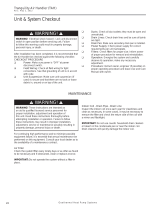
5
Plenums & Air Ducts
• Plenums and air ducts should be installed in
accordance with the standards of the National Fire
Protection Association Standard for Installation of
Air Conditioning Systems (NFPA 90A), Standard for
Installation of Residence Type Warm Air Heating
and Air Conditioning Systems (NFPA 90B), and all
applicable local codes. NFPA publications are available
by writing to: National Fire Protection Association,
Batterymarch Park, Quincy, ME 02269 or visit
www.NFPA.org online.
WARNING:
All return ducts must be secured to the air
handler using appropriate methods. All return
ducts must be adequately sealed. When return
air is provided through the bottom of the unit,
the joint between the air handler and the return
air plenum must be air tight.
Return air and circulating air ducts must not be
connected to any other heat producing device
such as a fireplace insert, stove, etc. This may
result in fire, explosion, carbon monoxide
poisoning, personal injury, or property damage.
• Designtheductworkaccordingtomethodsdescribed
by the Air Conditioning Contractors of America (ACCA).
• Thisunitisdesignedonlyforusewithareturnandsupply
duct. The return air duct must have the same free area
as the opening provided on the air handler. The ducts
should be appropriately sized to the capacity of the air
handler to ensure its proper airflow rating.
• This unit should be located with consideration of
minimizing the length of the supply and return ducts.
See Table 4, (page 16), Table 5, (page 17), Table
6, (page 18), Table 7, (page 18), & Table 8, (page
19) and the rating plate for proper circulating airflow
data.
• Wheneverthesupplyorreturnairductspassthrough
the floor, a 1/4” thick noncombustible resilient gasket
must be used between the duct, unit and floor
• Use transition ttings if the supply and/or return air
openings of the unit do not match the duct openings.
These transitions should be dimensioned in accordance
with standard practice as specified in the ASHRAE
recommendations for duct transitions.
• The supply air ductwork must be of noncombustible
material for the first 24 inches from the unit. Some
installations with a short, straight run from the unit to
the first branch takeoff may require acoustical lining
inside the supply air ductwork. Consult with local codes
for requirements specific to your area.
• Flexible connectors may be used between the unit
and the ductwork to prevent transmission of vibration
from the unit to the structure. If electric heater kits are
installed, heat resistant material must be used for the
flexible connector at the supply air end of the unit.
• It is good practiceto seal all connections and joints
with industrial grade sealing tape or liquid sealant.
Requirements for sealing ducts vary from region to
region. Consult with local codes for requirements specific
to your area.
Supply Air Connections
The supply air must be delivered to the heated space by
duct(s) secured to the blower’s casing, running full size
and without interruption. Tape or seal all seams if required
by local code.
Upflow & Horizontal Applications: To attach the supply air
duct, bend the flanges (on top of the unit) outward 90°
with a pair of wide duct pliers. Position the duct on top of
the blower and secure together with sheet metal screws.
Downflow Applications: Position the blower over the duct
and secure together with sheet metal screws.
Return Air Connections
The return air must be delivered to the blower by duct(s)
secured to the casing, running full size and without
interruption. Tape or seal all seams if required by local code.
Upflow & Horizontal Applications: Position the blower over
the duct and secure together with sheet metal screws.
Downflow Applications: To attach the supply air duct,
bend the furnace flanges outward 90° with a pair of wide
duct pliers. Position the duct on top of the cased coil and
secure together with sheet metal screws.
Acoustical Duct Work
• Certain installations may require the use of acoustical
lining inside the supply duct work. Acoustical insulation
must be in accordance with the current revision of the
Sheet Metal and Air Conditioning Contractors National
Association (SMACNA) application standard for duct
liners. Duct lining must be UL classified batts or blankets
with a fire hazard classification of FHC-25/50 or less.
• Fiberductworkmaybeusedinplaceofinternalduct
liners if the fiber duct work is in accordance with the
current revision of the SMACNA construction standard
on fibrous glass ducts. Fibrous duct work and internal
acoustical lining must be NFPA Class 1 air ducts when
tested per UL Standard 181 for Class 1 ducts.
• Damping ducts, flexible vibration isolators, or pleated
media-style filters on the return air inlet of the air
handler may be used to reduce the transmission of
equipment noise eminating from the air handler. These
treatments can produce a quieter installation, particularly
in the heated space. However, they can increase the
pressure drop in the duct system. Care must be taken
to maintain the proper maximum pressure rise across
the air handler, temperature rise and flow rate. This
may mean increasing the duct size and/or reducing the
blower speed. These treatments must be constructed
and installed in accordance with NFPA and SMACNA
construction standards. Consult with local codes for
special requirements. For best sound performance, be
sure to install all the needed gaskets and grommets





















